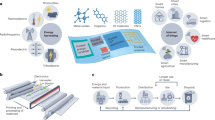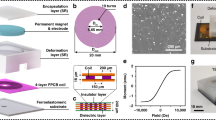Abstract
The electronics fields face serious problems associated with electric power; these include the development of ecologically friendly power-generation systems and ultralow-power-consuming circuits. Moreover, there is a demand for developing new power-transmission methods in the imminent era of ambient electronics, in which a multitude of electronic devices such as sensor networks will be used in our daily life to enhance security, safety and convenience. We constructed a sheet-type wireless power-transmission system by using state-of-the-art printing technologies using advanced electronic functional inks. This became possible owing to recent progress in organic semiconductor technologies; the diversity of chemical syntheses and processes on organic materials has led to a new class of organic semiconductors, dielectric layers and metals with excellent electronic functionalities1,2,3,4,5. The new system directly drives electronic devices by transmitting power of the order of tens of watts without connectors, thereby providing an easy-to-use and reliable power source. As all of the components are manufactured on plastic films, it is easy to place the wireless power-transmission sheet over desks, floors, walls and any other location imaginable.
This is a preview of subscription content, access via your institution
Access options
Subscribe to this journal
Receive 12 print issues and online access
$259.00 per year
only $21.58 per issue
Buy this article
- Purchase on Springer Link
- Instant access to full article PDF
Prices may be subject to local taxes which are calculated during checkout




Similar content being viewed by others
References
Katz, H. E. et al. A soluble and air-stable organic semiconductor with high electron mobility. Nature 404, 478–481 (2000).
Chua, L. L. et al. General observation of n-type field-effect behaviour in organic semiconductors. Nature 434, 194–199 (2005).
Bao, Z. N. Materials and fabrication needs for low-cost organic transistor circuits. Adv. Mater. 12, 227–230 (2000).
Yoon, M. H., Facchetti, A. & Marks, T. J. σ-π molecular dielectric multilayers for low-voltage organic thin-film transistors. Proc. Natl Acad. Sci. USA 102, 4678–4682 (2005).
Kobayashi, S. et al. Control of carrier density by self-assembled monolayers in organic field-effect transistors. Nature Mater. 3, 317–322 (2004).
Briseno, A. L. et al. Patterning organic single-crystal transistor arrays. Nature 444, 913–917 (2006).
Payne, M. M., Parkin, S. R., Anthony, J. E., Kuo, C. C. & Jackson, T. N. Organic field-effect transistors from solution-deposited functionalized acenes with mobilities as high as 1 cm2/Vs. J. Am. Chem. Soc. 127, 4986–4987 (2005).
Loo, Y. L. et al. Soft, conformable electrical contacts for organic semiconductors: High-resolution plastic circuits by lamination. Proc. Natl Acad. Sci. USA 99, 10252–10256 (2002).
Newman, C. R. et al. Introduction to organic thin film transistors and design of n-channel organic semiconductors. Chem. Mater. 16, 4436–4451 (2004).
Crone, B. et al. Large-scale complementary integrated circuits based on organic transistors. Nature 403, 521–523 (2000).
Meijer, E. J. et al. Solution-processed ambipolar organic field-effect transistors and inverters. Nature Mater. 2, 678–682 (2003).
Klauk, H., Zschieschang, U., Pflaum, J. & Halik, M. Ultralow-power organic complementary circuits. Nature 445, 745–748 (2007).
Dimitrakopoulos, C. D. & Malenfant, P. R. L. Organic thin film transistors for large area electronics. Adv. Mater. 14, 99–117 (2002).
Forrest, S. R. The path to ubiquitous and low-cost organic electronic appliances on plastic. Nature 428, 911–918 (2004).
Mcculloch, I. Thin films: Rolling out organic electronics. Nature Mater. 4, 583–584 (2005).
Sirringhaus, H. et al. High-resolution inkjet printing of all-polymer transistor circuits. Science 290, 2123–2126 (2000).
Garnier, F., Hajlaoui, R., Yassar, A. & Srivastava, P. All-polymer field-effect transistor realized by printing techniques. Science 265, 1684–1686 (1994).
Suo, Z., Ma, E. Y., Gleskova, H. & Wagner, S. Mechanics of rollable and foldable film-on-foil electronics. Appl. Phys. Lett. 74, 1177–1179 (1999).
Rogers, J. A. et al. Paper-like electronic displays: Large-area rubber-stamped plastic sheets of electronics and microencapsulated electrophoretic inks. Proc. Natl Acad. Sci. USA 98, 4835–4840 (2001).
Gelinck, G. H. et al. Flexible active-matrix displays and shift registers based on solution-processed organic transistors. Nature Mater. 3, 106–110 (2004).
Andersson, P. et al. Active matrix displays based on all-organic electrochemical smart pixels printed on paper. Adv. Mater. 14, 1460–1464 (2002).
Klauk, H., Gundlach, D. J., Nichols, J. A. & Jackson, T. N. Pentacene organic thin-film transistors for circuit and display applications. IEEE Trans. Electron Devices 46, 1258–1263 (1999).
Zhou, L. S. et al. All-organic active matrix flexible display. Appl. Phys. Lett. 88, 083502 (2006).
Baude, P. F. et al. Pentacene-based radio-frequency identification circuitry. Appl. Phys. Lett. 82, 3964–3966 (2003).
Rotzoll, R. et al. Radio frequency rectifiers based on organic thin-film transistors. Appl. Phys. Lett. 88, 123502 (2006).
Huang, D., Liao, F., Molesa, S., Redinger, D. & Subramanian, V. Plastic-compatible low resistance printable gold nanoparticle conductors for flexible electronics. J. Electrochem. Soc. 150, G412–G417 (2003).
Someya, T. et al. A large-area, flexible pressure sensor matrix with organic field-effect transistors for artificial skin applications. Proc. Natl Acad. Sci. USA 101, 9966–9970 (2004).
Someya, T. et al. Conformable, flexible, large-area networks of pressure and thermal sensors with organic transistor active matrixes. Proc. Natl Acad. Sci. USA 102, 12321–12325 (2005).
Someya, T. et al. Integration of organic FETs with organic photodiodes for a large area, flexible, and lightweight sheet image scanners. IEEE Trans. Electron Devices 52, 2502–2511 (2005).
Kato, Y. et al. Sheet-type braille displays by integrating organic field-effect transistors and polymeric actuators. IEEE Trans. Electron Devices 54, 202–209 (2007).
Acknowledgements
This study was partially supported by Special Coordination Funds for Promoting and Technology, the Ministry of Education, Culture, Sports, Science and Technology and JST/CREST. We also thank Kyocera Chemical Cooperation for providing high-purity polyimide precursors (KEMITITE CT4112), Daisankasei for a high-purity parylene (diX-SR) and H. Kawaguchi and K. Hizu for technical support.
Author information
Authors and Affiliations
Corresponding author
Ethics declarations
Competing interests
The authors declare no competing financial interests.
Supplementary information
Supplementary Information
Supplementary information and figures S1-S7 (PDF 816 kb)
Rights and permissions
About this article
Cite this article
Sekitani, T., Takamiya, M., Noguchi, Y. et al. A large-area wireless power-transmission sheet using printed organic transistors and plastic MEMS switches. Nature Mater 6, 413–417 (2007). https://doi.org/10.1038/nmat1903
Received:
Accepted:
Published:
Issue Date:
DOI: https://doi.org/10.1038/nmat1903
This article is cited by
-
A phased array based on large-area electronics that operates at gigahertz frequency
Nature Electronics (2021)
-
Flexible, sticky, and biodegradable wireless device for drug delivery to brain tumors
Nature Communications (2019)
-
Signal amplification with patterned conducting polymer electrodes based organic thin film transistor circuit
SN Applied Sciences (2019)
-
Two-wavelength infrared responsive hydrogel actuators containing rare-earth photothermal conversion particles
Scientific Reports (2018)
-
Stimuli-responsive polymeric materials functioning via host–guest interactions
Journal of Inclusion Phenomena and Macrocyclic Chemistry (2017)



